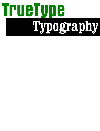
N.B. An asterisk before a word means it has its own entry in the glossary.
- 'EBDT' table (see also: 'bdat' table)
-
Embedded bitmap data table.
This TrueType (and *OpenType) table contains any bitmap *strikes for the font. These are used for *glyphs that would be very complicated to *hint, or simply to re-use old *bitmap fonts in new environments. See Microsoft's EBDT spec for the format in detail.
The name 'EBDT' was invented by Microsoft, but the table's format is identical to Apple's *'bdat' format. Presumably Microsoft did not want to be limited by Apple's specification, nor have to live up to it.
Bitmap tables are inactive under Windows 3.1, where the *outline and *hints are used instead. - 'EBLC' table (see also: 'bloc' table)
-
Embedded bitmap location table.
This TrueType (and *OpenType) table describes the information contained in the *'EBDT' table. See Microsoft's EBLC spec for the format in detail. - 'EBSC' table
-
Embedded bitmap scaling table.
This TrueType (and *OpenType) table describes how the bitmaps in the *'EBDT' table may be scaled. Although bitmap scaling is generally contrary to the spirit of *outline font technology, its use can be justified in large fonts of complex glyphs, e.g. *CJK fonts. See Microsoft's EBSC spec for the format in detail. - em square
-
The theoretical square that *glyphs are designed upon. Most TrueType fonts have an em-square of 2048 x 2048 units (powers of 2 being more efficient).
The size of the em-square (units per em, or "upem") is used with *ppem in the formula below for glyph scaling. Each co-ordinate is converted from design units (or FUnits), P, to distances in pixels, p in "device space":
p = P.ppem / upem - embedding bits
-
This data, stored in the *OS/2 table of TrueType and *OpenType fonts, states the level of embedding "permitted" by the font vendor. The levels may be combined by OR-ing together the relevant bits. The least restrictive bit takes precedence.
- Installable (0x0000) The font can be installed as a normal font on the receiving computer.
- Restricted Licence (0x0002) The font must not be embedded at all when only this bit is set.
- Preview & Print (0x0004) The font can be embedded, but no edits are allowed on transmitted documents and the font must not be available to any other part of the receiving computer system.
- Editable (0x0008) As above, but the document may be edited.
- No subsetting (0x0100) The font must not be *subsetted before embedding.
- Bitmaps only (0x0200) The font's *outline data must not be embedded.
N.B. Type designers are not entirely happy with the above specifications. When embedding was first proposed, it was reasonable to assume that fonts would usually not go far beyond their origins. But now anyone with a web browser may be using their proprietary data. Furthermore, most TrueType-generating software did not allow easy control over the settings, meaning that many fonts were shipped with "installable embedding", when it was the designer's strong intention (as expressed in the font's licence agreement) that nobody but the purchaser should have the font installed in any way on their system. Because of this, it's quite possible that software that fully respects embedding bits (e.g. Microsoft *WEFT) is illegally distributing proprietary font software around the Internet.
- embedding fonts
-
The inclusion of font files within a document file or website, so that documents and web pages can appear to all viewers with the intended typefaces. When an application receives a document with embedded fonts, it installs them - usually temporarily - so that the document will display and print correctly.
Before an application - such as Microsoft Word or *WEFT - embeds a TrueType or OpenType font, it must check the font's *embedding bits. Except with permanent embedding, the temporary fonts must be deleted from the system when the document is closed. Microsoft describes Embedding TrueType in more detail, and there's also a less technical FAQ.
The rogue type company Bitstream has developed the *TrueDoc system, which does not respect embedding permissions set by font vendors. - EOT
-
Embedded OpenType font. With a utility such as *WEFT, an OpenType font can be automatically compressed (by AGFA *Microtype Express technology) and *subsetted for efficient transfer across the web. You need Internet Explorer 4.0 to browse websites making use of EOT fonts. You cannot normally install EOT font files yourself.
- ESQ
-
Enhanced Screen Quality. This is Monotype's term for its TrueType fonts that have been very carefully *hinted. (Their non-ESQ TrueType fonts may have been automatically converted from a master format, resulting in only average quality hinting.) The name derives from the fact that hinting is of crucial importance when *scalable fonts are used at small *ppem sizes, and the screen is where those sizes are used most intensively. They are not compromised in any way for printing.
Although Monotype may object to other font companies using the term ESQ, this in no way prevents other companies (such as TYPE*chimérique or Font Bureau) hinting fonts to this level. - expert font
-
An additional font designed to accompany a standard font, providing a range of characters not included in the standard character map. With expert fonts installed, you break the 256-character barrier and can usually achieve the typographic richness of metal, with *ligatures, small capitals, old-style figures, etc. Expert fonts are just about useless without their companion standard fonts.
With *GX and *OpenType, the whole concept of expert fonts becomes redundant. Also banished are the associated annoyances of broken spell-checking and text searching, and the inability to change painlessly the typeface for a document.
TYPE*chimérique | TrueType Typography | TYPE*links